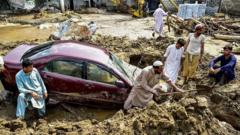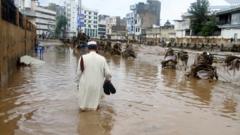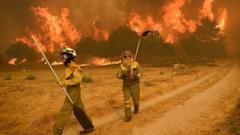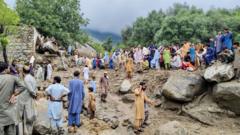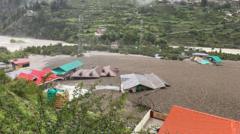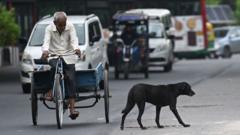The article explores how residents cope with escalating temperatures in India's hottest region, highlighting the challenges they face and the adaptations they've made in response to an increasingly hostile environment.**
Navigating Life Under Extreme Heat: Sri Ganganagar's Struggle for Survival**

Navigating Life Under Extreme Heat: Sri Ganganagar's Struggle for Survival**
As temperatures soar in India, residents of Sri Ganganagar adapt to the harsh realities of life with extreme heat.**
India is facing an unprecedented climate challenge as extreme heat takes a toll on its vast population. Currently, daytime temperatures in some regions, particularly in the desert state of Rajasthan, have climbed dangerously close to 50 degrees Celsius (122 degrees Fahrenheit). The ongoing heatwave puts three-quarters of the country's 1.4 billion people at risk, compelling them to develop new daily routines to cope with an increasingly harsh environment.
During a recent visit to Sri Ganganagar, one of India's hottest cities, the situation on the ground became tangible. On the day of our visit, temperatures hit a sweltering 47 degrees Celsius (117 degrees Fahrenheit), and forecasts for the following day predicted even more oppressive heat, with highs reaching 49 degrees Celsius (121 degrees Fahrenheit). The relentless heat, coupled with rising humidity levels—a product of climate change—exacerbates the challenges faced by the residents.
Facing this relentless weather, many residents find themselves adapting their routines. Traditional work hours have often shifted to cooler parts of the day, with early mornings or late evenings becoming the preferred times for outdoor activities. However, not all can afford air conditioning or respite from the sun, leading many to carry on their daily tasks in direct sunlight, as not working translates to not earning.
Sri Ganganagar's livelihood is intrinsically tied to its extreme weather patterns. Agriculture, a major facet of the local economy, is at risk as crops struggle to survive the unprecedented heatwaves. Medical services are stretched thin as heat-related illnesses spike, affecting overall community health standards.
The reality on the ground reflects a significant shift in how life unfolds amidst a changing climate. While the people of Sri Ganganagar have always dealt with high temperatures, the current conditions demand a level of adaptation that tests resilience. As India continues to grapple with extreme weather phenomena, the urgent need for adaptive measures and crisis management strategies becomes clear.
In the face of these extreme realities, the lives of ordinary citizens in this sweltering region reveal a narrative of survival, innovation, and the profound impact of climate change on everyday existence.
During a recent visit to Sri Ganganagar, one of India's hottest cities, the situation on the ground became tangible. On the day of our visit, temperatures hit a sweltering 47 degrees Celsius (117 degrees Fahrenheit), and forecasts for the following day predicted even more oppressive heat, with highs reaching 49 degrees Celsius (121 degrees Fahrenheit). The relentless heat, coupled with rising humidity levels—a product of climate change—exacerbates the challenges faced by the residents.
Facing this relentless weather, many residents find themselves adapting their routines. Traditional work hours have often shifted to cooler parts of the day, with early mornings or late evenings becoming the preferred times for outdoor activities. However, not all can afford air conditioning or respite from the sun, leading many to carry on their daily tasks in direct sunlight, as not working translates to not earning.
Sri Ganganagar's livelihood is intrinsically tied to its extreme weather patterns. Agriculture, a major facet of the local economy, is at risk as crops struggle to survive the unprecedented heatwaves. Medical services are stretched thin as heat-related illnesses spike, affecting overall community health standards.
The reality on the ground reflects a significant shift in how life unfolds amidst a changing climate. While the people of Sri Ganganagar have always dealt with high temperatures, the current conditions demand a level of adaptation that tests resilience. As India continues to grapple with extreme weather phenomena, the urgent need for adaptive measures and crisis management strategies becomes clear.
In the face of these extreme realities, the lives of ordinary citizens in this sweltering region reveal a narrative of survival, innovation, and the profound impact of climate change on everyday existence.

